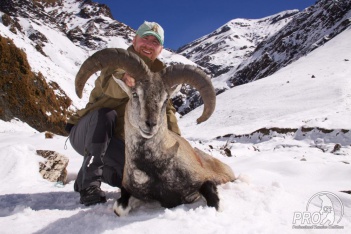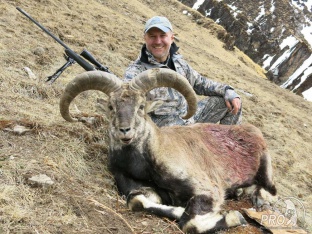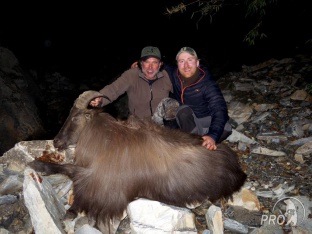Blue Sheep in Nepal
Blue Sheep or Bharal (pseudois nayaur nayaur) is a strikingly handsome animal. Shoulder height 30-35 inches/75-90 cm. Weight 130-150 pounds/60-70 kg. Females are smaller then males. General color is brown-gray in summer, becoming bluish-gray in winter. The rump patch, belly, inside and back of legs, and undersides of jaw are white. There is a conspicuous black stripe down the front of the legs, a horizontal black stripe dividing belly from flanks, and a dark facial mask. In adult males, front of neck and chest are black. The coat is harsh and springily, with thick underwool in winter. The dark, olive-colored, supracervical horns are similar to those of the Dagestan tur of the eastern Caucasus. Smooth and rounded, with heavy bases, they curve almost horizontally outward, then down and back above the neck with the tips pointing slightly up. In cross section they are almost square, with four pronounced edges and flat horn. Gregarious, associating in herds averaging 5-20, although sometimes as many as 100-200. Mating season is October-December. Habitat in open slopes and plateaus with abundant grass at altitudes of 9800-18000 feet/3000-5500 m. Distribution from the Himalayas northward across the Tibetan Plateau to the Kunlun Shan and Nan Shan ranges, and from Hunza (Pakistan) and Ladakh (India) eastward to Sichuan and Gansu province of China, and extreme southwestern Inner Mongolia.
Himalayan Tahr (hemitragus jemlahicus) is an excellent game animal that provides sport as fine as any in the world. The Himalayan Tahr is one of three species of Tahr. Himalayan Tahrs have relatively short legs and small heads with large eyes and small pointed ears. Males are larger than females, they weigh between 80 and 200 pounds/35–90 kg. They are 26–40 inches/66–100 cm at the shoulder, and 4–5 ft/120–150 cm long. Their hooves have a hard keratin rim surrounding a soft spongy convex pad. These hooves and their dewclaws make them excellent climbers. Both sexes have horns which curve up, back, and then in. They can grow up to 18 inches/45 cm long and are bigger on males than on females. In the winter Tahr has dense, reddish to dark brown woolly fur with a thick undercoat, which keeps it warm. The males will grow a long, shaggy mane around their neck and shoulders, which grows down to the upper parts of their legs. In the spring they lose much of their coat, and it becomes lighter in color.
Area
Mid-West Nepal, “Dhorpatan Hunting Reserve” (Surtibang, Gustang, Barse and Fagune, Southern Areas of Dhorpatan).
Hunting season
March and April in spring season and October - November in fall season. Best time is April and end of October to beginning November.
Route
The most convenient way to travel to Kathmandu (Nepal) with arm and ammunition is by Qatar Airways or Turkish Airlines. The hunter will be met in Kathmandu by our representative and accompanying the whole trip. Usually the first day (by arrival before noon) we need about 3 hours to complete all governmental formalities, gun import and hunting license. After some afternoon sightseeing in Kathmandu and overnight in hotel next morning you will be transferred by helicopter to the hunting area near Dhorpatan - 1,5 hours. In about one or two days of hiking—depending of the block you will approach the hunt.
Camp & Accommodation
Along the whole time in the mountains we do use tented camps. We have separate sleeping tents one per each client, dining tents with folding chairs and table. Crew is about 20 people: porters (sherpas), guides, cooking team. You will find very good food and a quality service.
Climate
The higher elevations remain snow-capped throughout the year. Trees like fir, pine, birch, rhododendron, hemlock, oak, juniper and spruce are common in the reserve. It is good to have layered clothes because the temperature is low in the morning and in the evening and it is higher during the day. Snow and rain can be expected in early October and some chances of snow are in March and even in April.
Hunting
Blue Sheep hunting is a very hard hunt due to the altitude involved. That is why we firstly complete Sheep hunt, and only if there is time, we look for other game. Due to the altitude we are careful to land with the helicopter at about 9000 feet (3000 m) and from here we take one or two days walk to the sheep base camp in order the hunters to get acclimatized to the altitude. Hunters go out each morning and are back at night to base camp. Each hunter accompanied by 1 hunting guide and 1 local guide goes out at about 3:30 a.m. with a lunch packed. Blue Sheep hunt is organized from about 11500 feet/3500 m to about 14800 feet/4500 m, sometimes up to 18000 feet/5500 m. Tahr hunt is done about 9800 feet/3000 m. Success rate is almost 100%.
Schedule for Blue Sheep and Tahr combo hunt
Day 1 Arrival in Kathmandu in the morning, custom formalities (it takes 2 - 3
hours including all government formalities ), transfer to the hotel.
Sightseeing in the afternoon.
Day2 Transfer by helicopter - 1,5 hours to the heli-spot in Dhorpatan hunting
reserve (about 9000 feet/ 3000 meters, then hiking to the hunting spot
of blue sheep.
Day 3 Hiking to the hunting spot of blue sheep
Day 4-10 7 days of hunting blue sheep.
Day 11 Hiking to the Himalayan tahr area
Day12 - 16 5 days of hunting Himalayan tahr and possible other additional trophies:
muntjac (muntiacus muntjak), wild boar
Day 17 Hiking back to the heli-spot
Day 18 Transfer by helicopter to Kathmandu, overnight at the hotel.
Day 19 Departure home.



